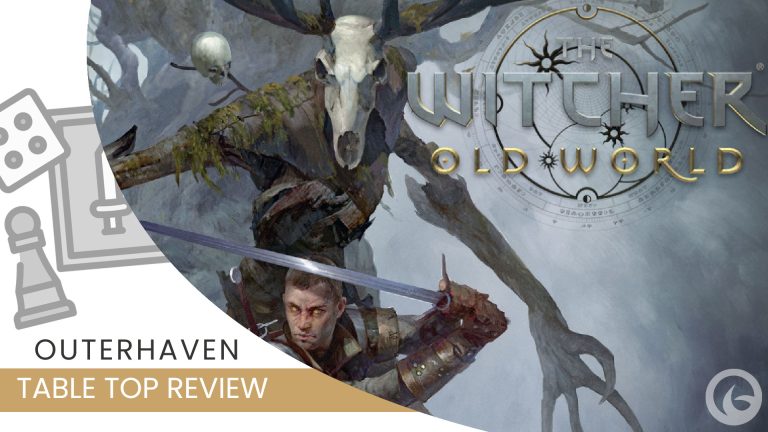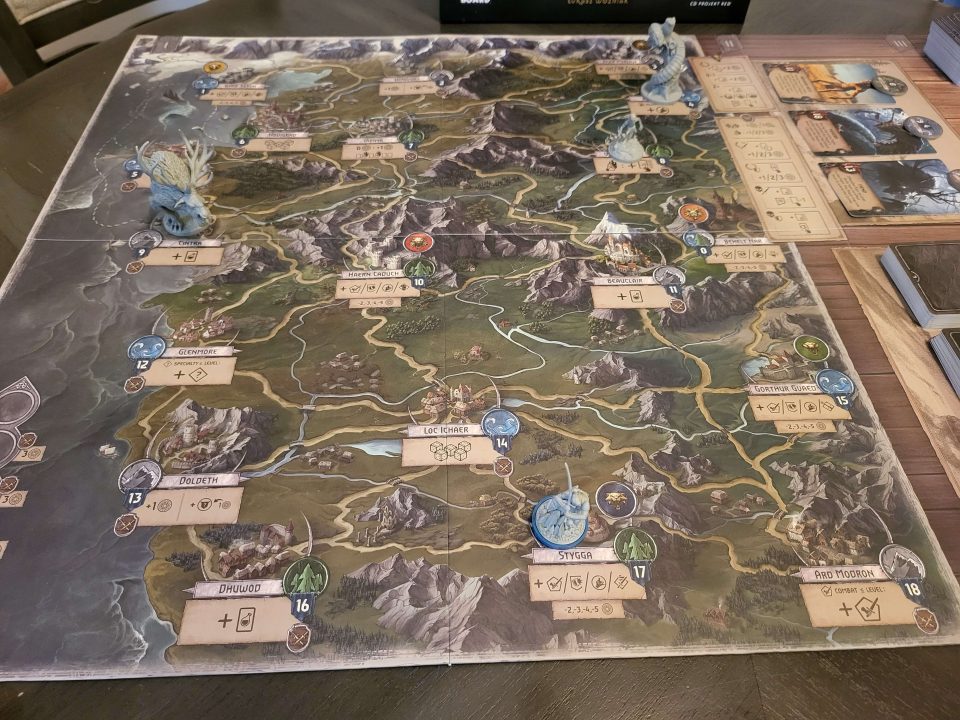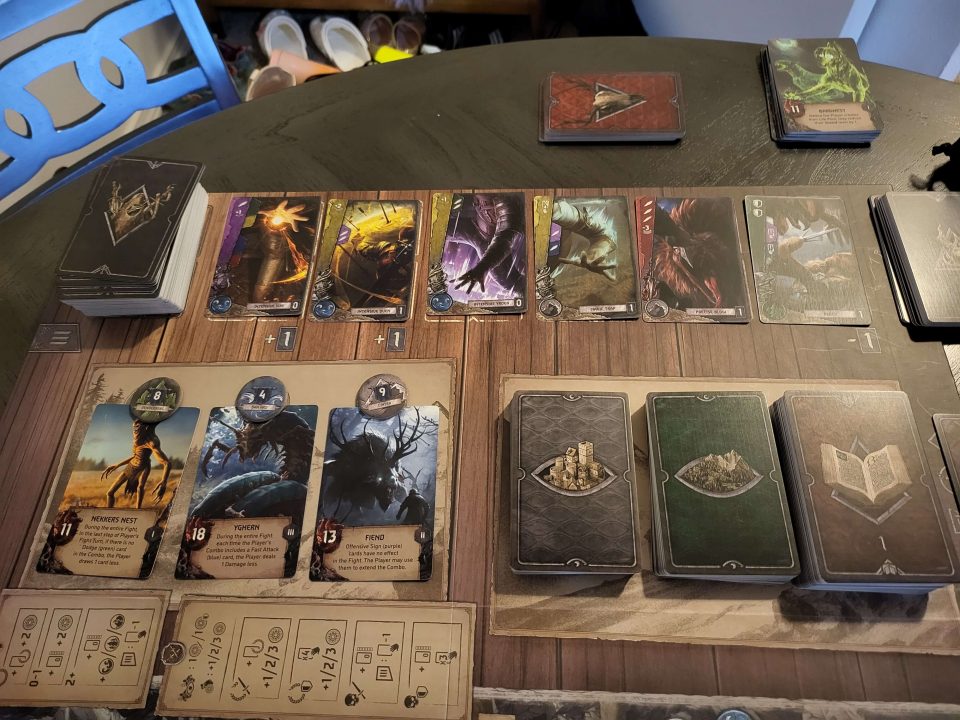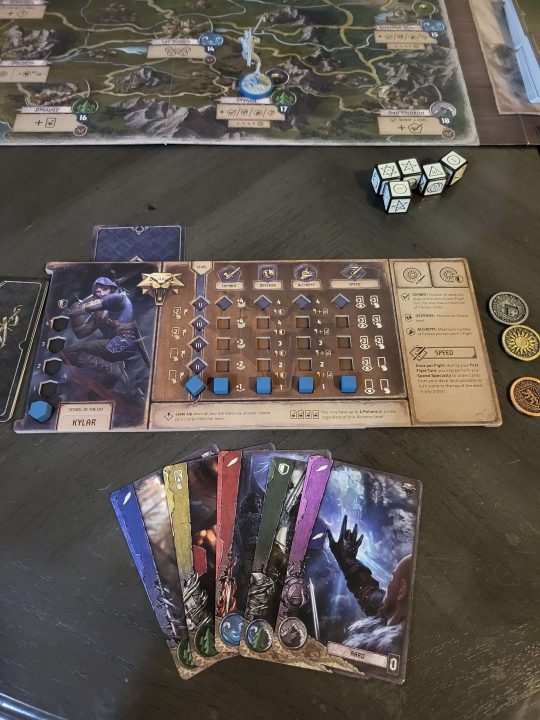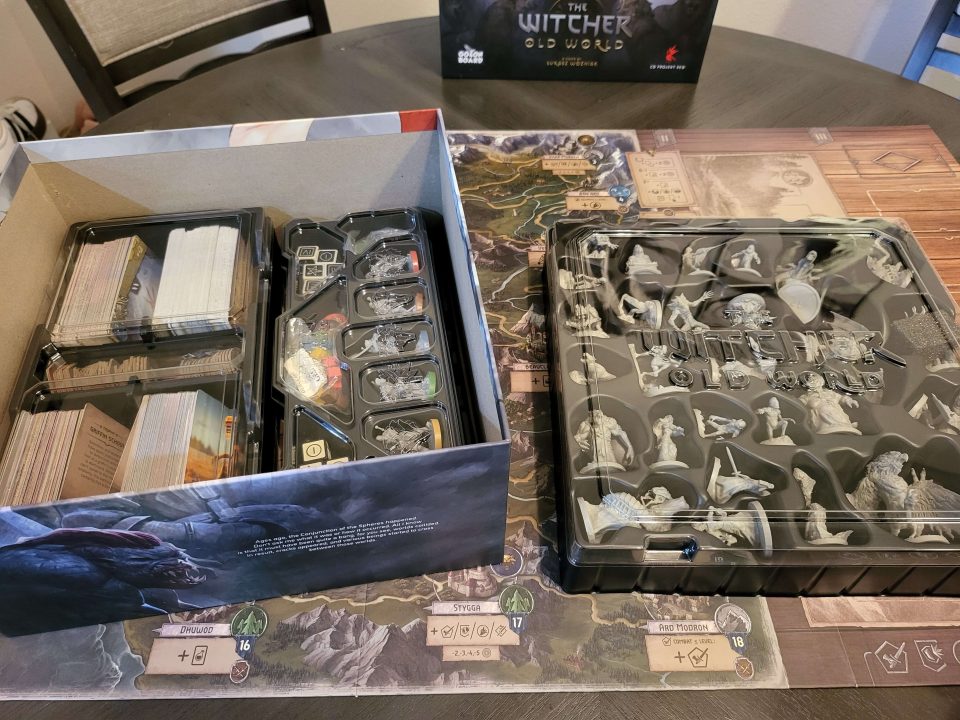The Witcher: Old World isn’t Geralt’s story – it’s yours. It’s the smell of mead, steel, and monster guts on the table, where five witcher schools chase coin, trophies, and scars. You’ll need to train well and stock up on potions if you’re going to survive.
Title: The Witcher: Old World
Publisher: Go On Board, CD Projekt Red
Designer: Lukasz Wozniak
Players: 1-5
Playtime: 90-150 Minutes (Pretty accurate)
Genre: Thematic, Deck Builder
Release: 2023
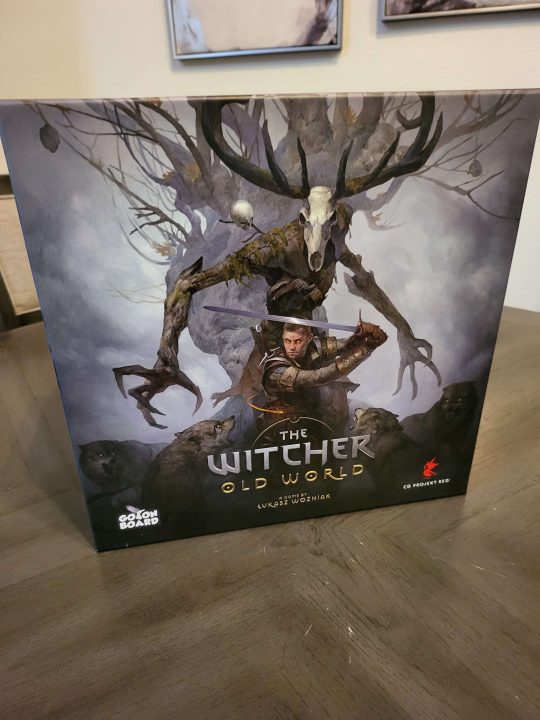
Running the Continent
Each player will take on the role of a Witcher from one of the five schools: Wolf, Bear, Cat, Viper, and Griffin, to travel across the Continent in search of fame. Gain trophies by fighting monsters, Witchers, or leveling an attribute to the highest level and meditating.
Every turn in The Witcher: Old World, you grow stronger, increasing your action deck, attributes, and level. Deck-building combat with attacks, dodges, and Signs is the heartbeat of the game. Your action cards can become a combo that allows you to Yrden an opponent, dodge into a strong attack, and finish with an Intensive Aard to send them flying. Your action deck doubles as your “life pool”, so when you run out of cards, it’s essentially you getting “knocked out” by a Nekker who runs away, taking some of your dignity with it.
Throughout the game, you’ll be trying to learn new skills, track and kill monsters, play dice poker, and avoid conflicts with other Witchers (or instigate them). I had a lot of fun learning how the cards combo together and how to manage your action deck during a fight.
Mechanics
- On Phase I of your turn, you’ll use your action cards to move and perform Location Actions, which can include: gaining a potion, playing dice poker, or leveling up attributes, among a few others, and you can do these even if a monster is on that location.
- Phase II is the Fight/Meditate/Explore part of your turn. You can fight a monster, which is where most trophies come from, level up an attribute to 5, and meditate or explore the City/Wilds for a more thematic option. Other players can help if you choose to explore, a nice touch that combines players like this.
- Phase III is Drawing and Gaining. This is where you rest and recover by resetting your hand of cards and gaining a new one from the board.
You’ll need to train like a real Witcher, Mastering Fast and Strong attacks, Dodging, and Utilizing Offensive and Defensive Signs (blue, red, green, purple, and yellow). On top of that, you need to level up your attributes: Combat to draw more cards during fights, Defense to block more damage, Alchemy to use more potions per fight, and Specialty, which is a unique skill to each Witcher. Level each of those to 2 or higher, and you level up.
It takes a lot of work to be a Witcher, but every little bit helps you survive the Relic you’ve been tracking. I really enjoy that all the aspects you’d expect from a Witcher game are here; the only thing missing is bombs (included in an expansion).
Theme and components
Go On Board poured the same obsessive love into this board game world as CD Projekt Red did into their digital world. The art sets the same atmosphere (like the Leshen on the cover), the minis are sculpted like they could crawl off the board, and even the cards capture the essence of every skill you’re using.
The art and mechanics are beautiful, but the deluxe edition is where it really stands out. Instead of cardboard, having your Witcher come face-to-face with a Griffin on the table is how you get to the heart of it. The quality of components is fantastic, and the storage remains easy, with all the minis still fitting in the box. The metal coins are a very well-done and add a fun thematic way to get paid for contracts, but are an extra purchase.
Ease of learning
The rulebook is quite dense, and can be difficult to track down specific rules, as there are a lot of options per turn. The general idea, however, isn’t so difficult – you’ll travel, train, fight, and rest. I would set this game more for the hobby gamers over casual gamers, but with the right patience, casuals will be right at home and completing a contract to track down a werewolf.
Expansions
- Skellige gives a sideboard for sea travel
- Legendary Hunt pushes the adventure even further with towering beasts for those who can’t stop hunting, like myself
- Mages adds 5 playable mages, a new board spot for their own card system, and asymmetry to the table
- Monster Trail, Adventure Pack, and Ciri spice things up with 2 new playable characters, bombs, mutagens, and 200 exploration and event cards
Solo
With just some minor changes (mostly in setup), it can turn into a solo, monster-slaying adventure. It plays well with no noticeable drawbacks, and the end game has a little bonus depending on how many rounds it took. I have played this a couple of times to learn the different Witchers’ playstyles (my pictures are from solo mode).
My take
If you like to live in the world of Witchers, whether it be in the video game, books, or the TV show, this game is a welcome addition. It encompasses the core feel without missing out on what makes the Continent so captivating: danger, choice, and the thrill of the hunt. It’s about carving your own legend in a world that doesn’t care if you live or die. Every potion brewed, every Sign cast, and every monster slain feels like a story worth hearing. And for fans who’ve ever wanted to hang up their controller, but stay in the world, pick up a sword – or a deck – this is where your tale begins.
If you’d like to purchase it, you can here at the Miniature Market website
Summary
The Witcher: Old World isn’t about replaying the video game – it’s about living in its legend. It trades button-mashing for deck-building, reflex for risk, and in doing so, proves that being a Witcher was never about the sword, but the story you make of it.
Pros
- Stunning art and components
- Rewarding combat and progression
- Immersive world and expansions add real depth and struggle
Cons
- Lengthy setup and playtime
- Rulebook can intimadate first time players
- Downtime between turns in larger groups


